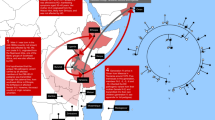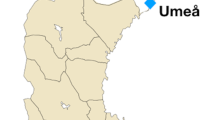Abstract
Analysis of 78 Huntington's disease (HD) chromosomes with multi–allele markers revealed 26 different haplotypes, suggesting a variety of independent HD mutations. The most frequent haplotype, accounting for about one third of disease chromosomes, suggests that the disease gene is between D4S182 and D4S180. However, the paucity of an expected class of chromosomes that can be related to this major haplotype by assuming single crossovers may reflect the operation of other mechanisms in creating haplotype diverstiy. Some of these mechanisms sustain alternative scenarios that do not require a multiple mutational origin for HD and/or its positioning between D4S182 and DAS180.
This is a preview of subscription content, access via your institution
Access options
Subscribe to this journal
Receive 12 print issues and online access
$209.00 per year
only $17.42 per issue
Buy this article
- Purchase on Springer Link
- Instant access to full article PDF
Prices may be subject to local taxes which are calculated during checkout
Similar content being viewed by others
References
Martin, J.B. & Gusella, J.F. New Engl. J. Med. 315, 1267–1276 (1986).
Gusella, J.F. Adv. hum. Genet. 20, 125–151 (1991).
MacDonald, M.E. et al. Neuron 3, 183–190 (1989).
Snell, R.G. et al. J. med. Genet. 26, 673–675 (1989).
Theilmann, J. et al. J. med. Genet. 26, 676–681 (1989).
Novelletto, A. et al. Am. J. med. Genet. 40, 374–376 (1991).
Adam, S. et al. Am. J. hum. Genet. 48, 595–603 (1991).
MacDonald, M.E. et al. Am. J. hum. Genet. 49, 723–734 (1991).
Kerem, B. et al. Science 245, 1073–1080 (1989).
Lin, C.S. et al. Somat. Cell molec. Genet. 17, 481–488 (1991).
Bates, G.P. et al. Am. J. hum. Genet. 49, 7–16 (1991).
Taylor, S.A.M., Barnes, G.T., MacDonald, M.E. & Gusella, J.F. Nucleic Acids Res. (in the press).
Allitto, B.A. et al. Nucleic Acids Res. 19, 4015 (1991).
Wasmuth, J.J. et al. Nature 332, 734–736 (1988).
Stevens, D. & Parsonage, M. J. Neurol. Neurosurg. Psychiatry 32, 140–143 (1969).
Shaw, M. & Caro, A.J. J. med. Genet. 19, 161–167 (1982).
Seizinger, B.R., Martuza, R.L. & Gusella, J.F. Nature 322, 664–667 (1986).
Anderson, M.A. & Gusella, J.F. In Vitro 11, 856–858 (1984).
Gusella, J.F. et al. Proc. natn. Acad. Sci. U.S.A. 76, 5239–5243 (1979).
Gusella, J.F. et al. Nature 306, 234–238 (1983).
Feinberg, A.P. & Vogelstein, B. Anal. Biochem. 137, 266–267 (1984).
Whaley, W.L. et al. Somat. Cell molec. Genet. 17, 83–91 (1991).
Author information
Authors and Affiliations
Rights and permissions
About this article
Cite this article
MacDonald, M., Novelletto, A., Lin, C. et al. The Huntington's disease candidate region exhibits many different haplotypes. Nat Genet 1, 99–103 (1992). https://doi.org/10.1038/ng0592-99
Received:
Accepted:
Issue Date:
DOI: https://doi.org/10.1038/ng0592-99
This article is cited by
-
Whole genome and exome sequencing realignment supports the assignment of KCNJ12, KCNJ17, and KCNJ18 paralogous genes in thyrotoxic periodic paralysis locus: functional characterization of two polymorphic Kir2.6 isoforms
Molecular Genetics and Genomics (2016)
-
Linkage disequilibrium interval mapping of quantitative trait loci
BMC Genomics (2006)
-
Satellog: A database for the identification and prioritization of satellite repeats in disease association studies
BMC Bioinformatics (2005)
-
Discovering genotypes underlying human phenotypes: past successes for mendelian disease, future approaches for complex disease
Nature Genetics (2003)



